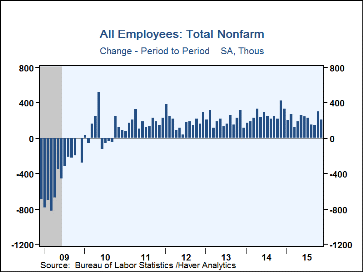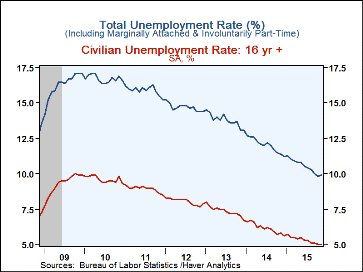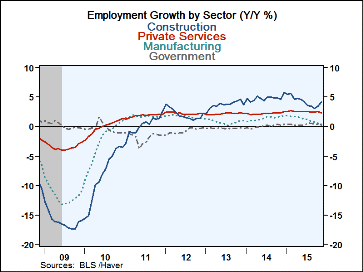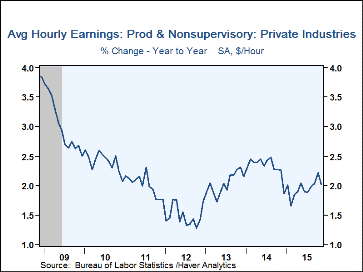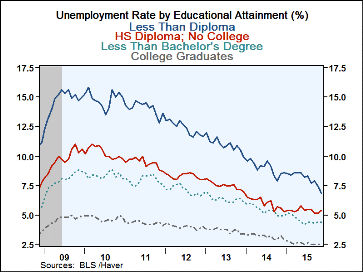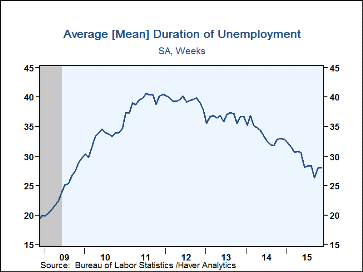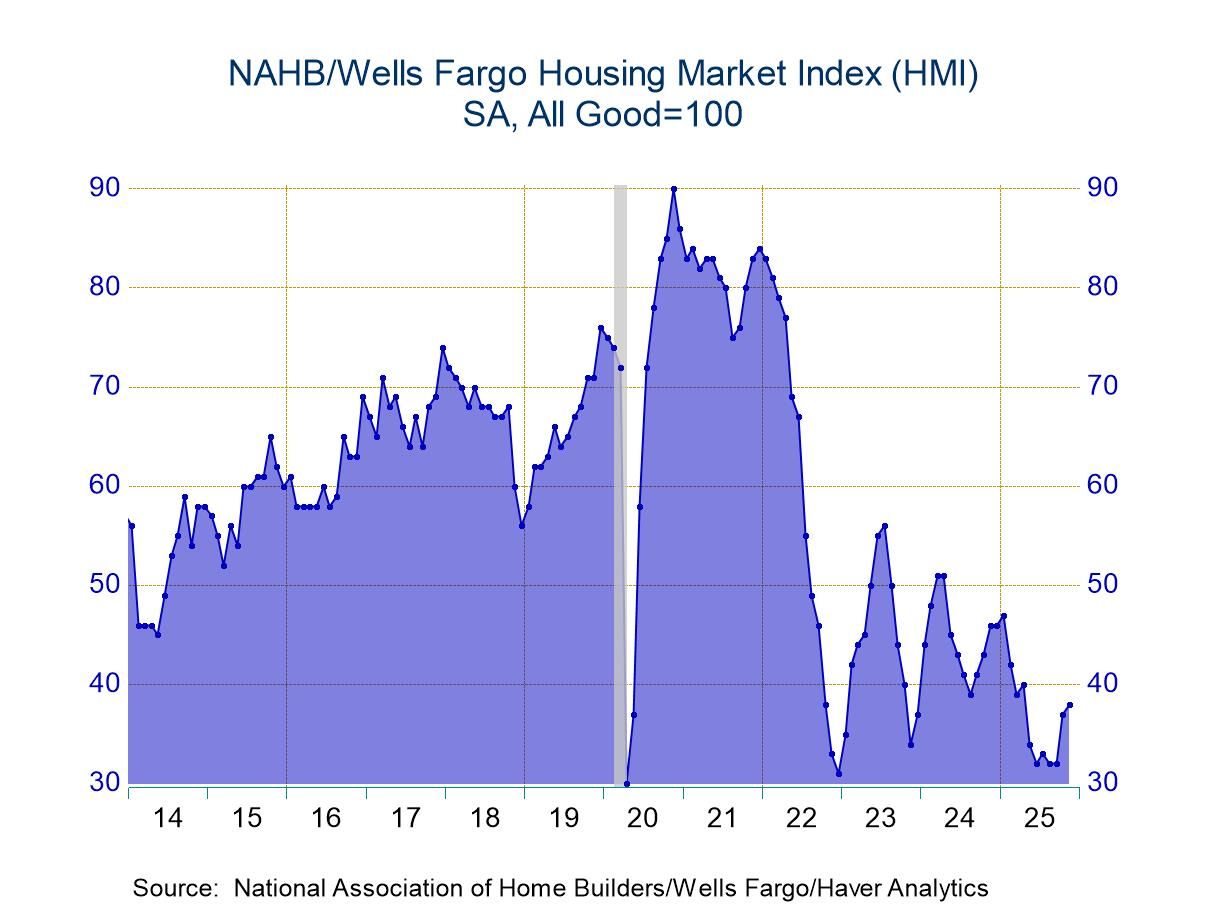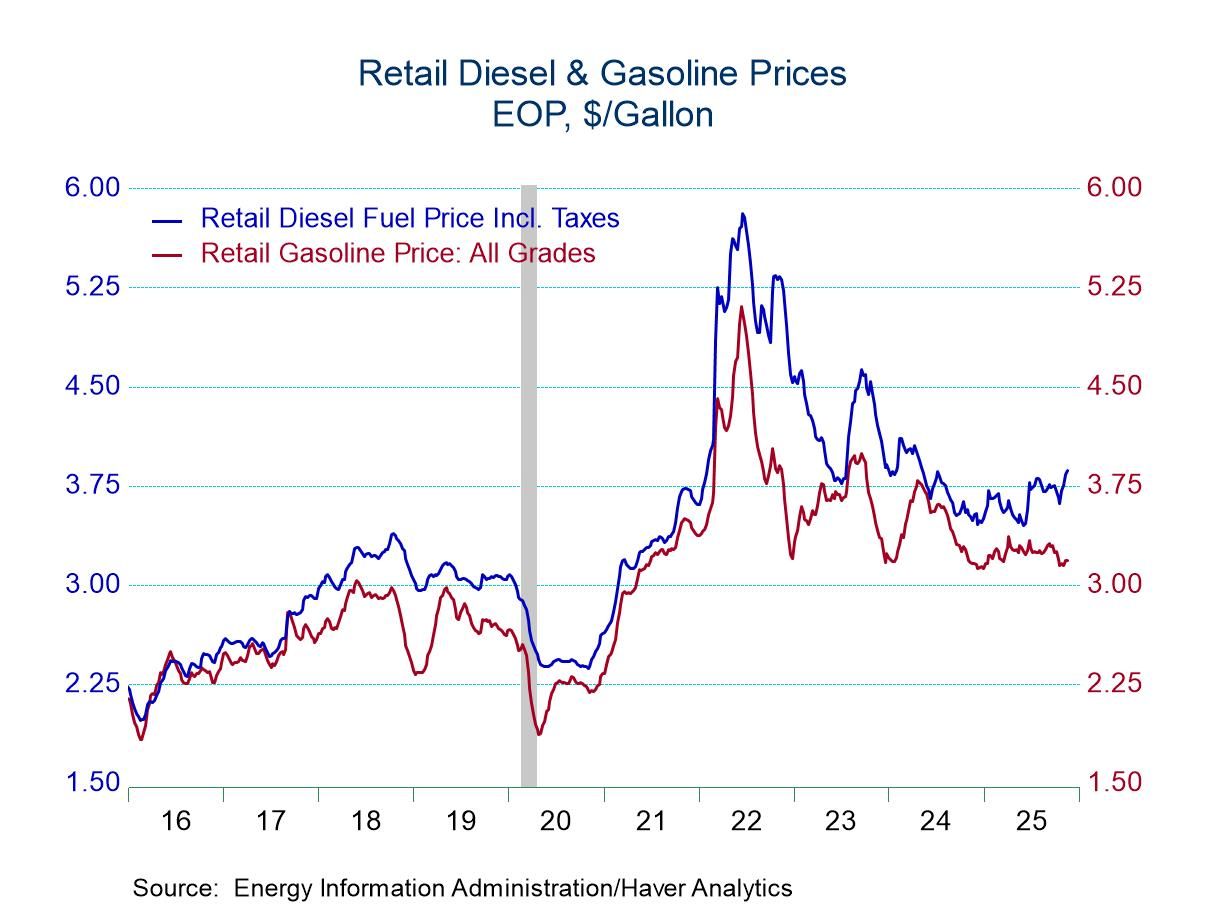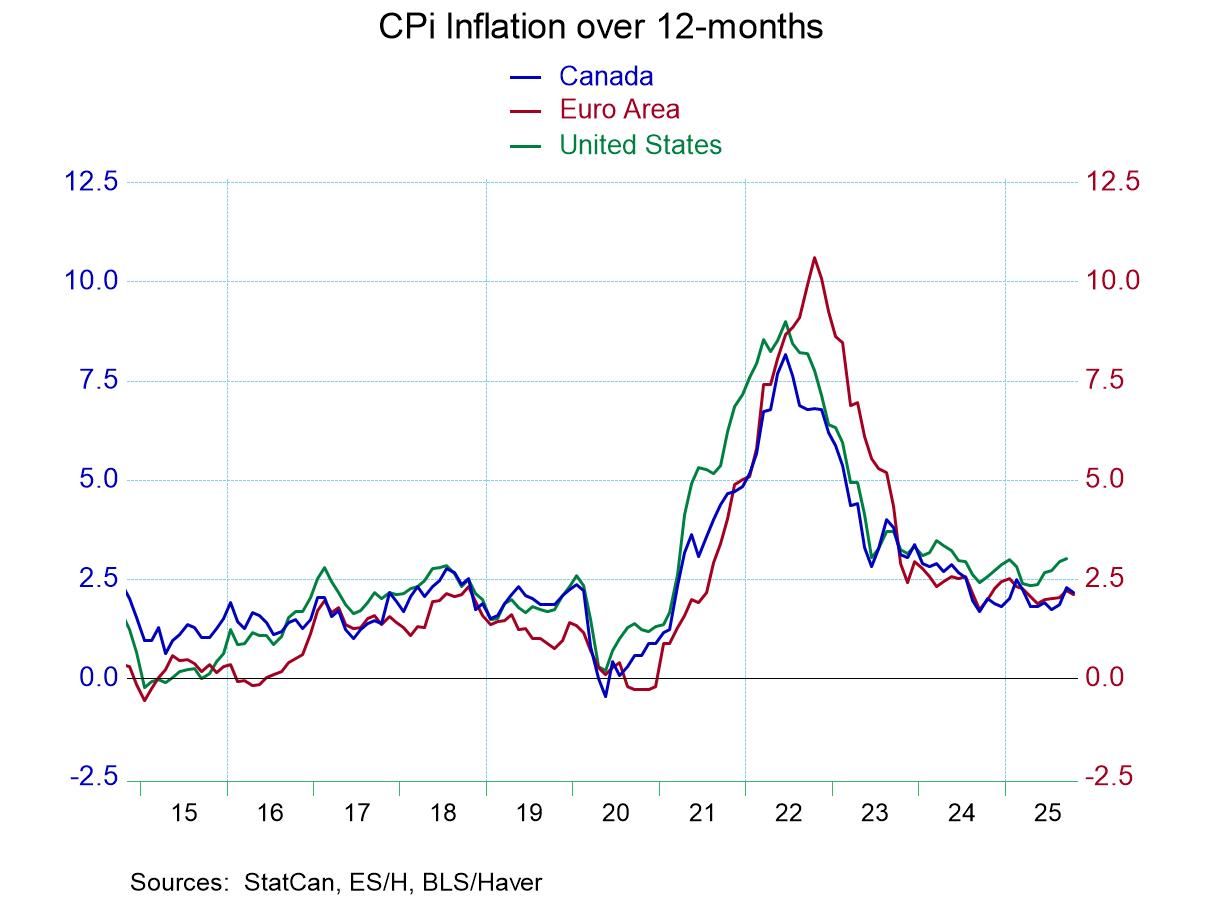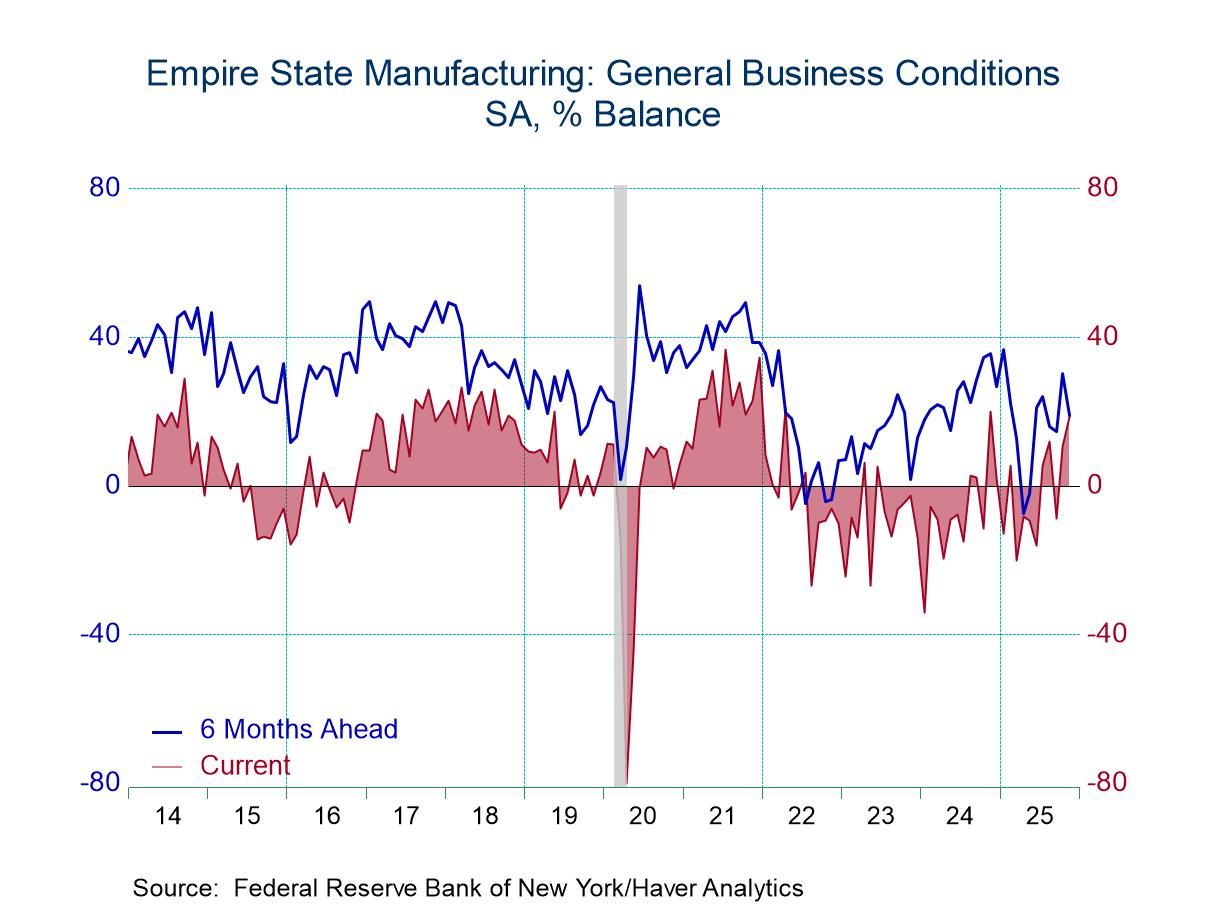 Global| Dec 04 2015
Global| Dec 04 2015U.S. Payrolls Rise Moderately: Unemployment Rate Stabilizes While Earnings Gains Ease
by:Tom Moeller
|in:Economy in Brief
Summary
Nonfarm payrolls grew 211,000 during November following upwardly revised gains of 298,000 and 145,000 during the prior two months. The increase outpaced expectations for a 200,000 gain in the Action Economics Forecast Survey. The rise [...]
Nonfarm payrolls grew 211,000 during November following upwardly revised gains of 298,000 and 145,000 during the prior two months. The increase outpaced expectations for a 200,000 gain in the Action Economics Forecast Survey. The rise in employment was accompanied by expected stability in the unemployment rate at 5.0%. The overall unemployment rate, including marginally attached workers and those employed part-time for economic reasons, ticked up to 9.9%. Moreover, firm jobs readings did not accelerate improvement in hourly earnings. The 0.2% gain matched expectations but eased from 0.4% in October.
From the payroll survey, the 211,000 rise in November employment left the three-month average increase at 218,000, the firmest rise since July. The manufacturing sector did not participate, however, as payrolls eased 1,000 last month and by an average 3,000 over the last three. Strength in the construction sector compensated for this weakness and the 46,000 job gain was the strongest since January 2014 and three-month growth of 33,000 was the best in nine months. Mining & logging employment declined 11,000 (-13.5% y/y). It has fallen in each month this year.
Job growth in the private service sector eased. The 163,000 rise last month was the weakest since August and left three-month average growth a fairly steady 202,000. Leisure & hospitality employment gained 39,000 (3.0% y/y) and three-month growth of 46,000 equaled the strongest in nine months. Health care & social assistance jobs grew 32,200 (3.2% y/y), posting a diminished 46,700 three-month average. Retail trade jobs advanced 30,700 (1.8% y/y), and the three-month gain was fairly steady at 27,200. Professional & business service employment increased 27,000 (3.2% y/y), the weakest rise since January but the three-month rise held steady at 50,000. Within that category, temporary help jobs fell 12,300 (+2.6% y/y), the first decline since July. Financial sector jobs improved 14,000 (1.8% y/y), but three-month growth of 9,000 was half the growth at the beginning of the year. Government sector payrolls increased 14,000 (0.4% y/y).
The length of the average workweek dipped to 34.5 hours and reversed its September rise. So far in Q4, the average is slightly below Q3. Aggregate hours worked (employment times hours) are up 2.1% (AR) versus Q3.
Average hourly earnings increased 0.2% following the 0.4% October increase. Construction sector earnings rose 0.3% (2.7% y/y), half the prior month's rise. Factory sector workers realized only a 0.1% rise (2.1% y/y), also half the earlier gain. Private service sector earnings improved 0.2% (2.3% y/y), half the prior month's rise. Earnings in trade, transportation and utilities fell 0.1% (+2.1% y/y) after a 0.5% jump in October. Information industries produced a faster 0.8% rise (3.7% y/y) but leisure & hospitality earnings ticked up just 0.1% (2.6% y/y), following a 0.4% increase. Earnings in the financial sector rose 0.4% (2.4% y/y) following no change.
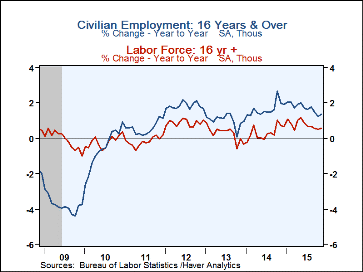 From the household survey, the unemployment rate's stability at 5.0%
left it down from the 10.0% peak in December 2009. Civilian employment increased
244,000 (1.4% y/y) while the labor force gained 273,000 (0.6% y/y). The labor
force participation rate notched higher m/m to 62.5%, but remained nearly the
lowest since late-1977. The number of persons not in the labor force grew 2.2% y/y.
From the household survey, the unemployment rate's stability at 5.0%
left it down from the 10.0% peak in December 2009. Civilian employment increased
244,000 (1.4% y/y) while the labor force gained 273,000 (0.6% y/y). The labor
force participation rate notched higher m/m to 62.5%, but remained nearly the
lowest since late-1977. The number of persons not in the labor force grew 2.2% y/y.
The unemployment rate for those without a high school diploma eased to 6.9%, down from its 2010 high of 15.8%. For high school graduates without a college diploma, the rate of 5.4% was below the 11.0% high. For high school graduates with some college, the jobless rate was 4.4%, down from the 8.9% high and for college grads, the unemployment rate of 2.5% was half the 2010 high.
The average duration of unemployment held steady at 28.0 weeks, down from the 2011 high of 40.6 weeks. Nineteen percent of those unemployed had been out of work for 52 weeks or longer, down from the 2010 high of 31.9%.
The labor market data is contained Haver's USECON database. Detailed figures are in the EMPL and LABOR databases. The expectations figure is in the AS1REPNA database.
Sentiment of the FOMC: Unscripted from the Federal Reserve Bank of Kansas City is available here.
| Employment: (SA, M/M Change, 000s) | Nov | Oct | Sep | Y/Y | 2014 | 2013 | 2012 |
|---|---|---|---|---|---|---|---|
| Payroll Employment | 211 | 298 | 145 | 1.9% | 1.9% | 1.7% | 1.7% |
| Previous | -- | 271 | 137 | -- | -- | -- | -- |
| Manufacturing | -1 | 1 | -8 | 0.3 | 1.4 | 0.8 | 1.7 |
| Construction | 46 | 34 | 19 | 4.2 | 4.8 | 3.7 | 2.1 |
| Private Service Producing | 163 | 274 | 169 | 2.4 | 2.2 | 2.2 | 2.2 |
| Government | 14 | -6 | -20 | 0.4 | 0.0 | -0.3 | -0.8 |
| Average Weekly Hours - Private Sector | 34.5 | 34.6 | 34.5 | 34.6 (Nov.'14) |
34.5 | 34.5 | 34.4 |
| Private Sector Average Hourly Earnings (%) | 0.2 | 0.4 | 0.1 | 2.3 | 2.1 | 2.1 | 1.9 |
| Unemployment Rate (%) | 5.0 | 5.0 | 5.1 | 5.8 (Nov.'14) |
6.1 | 7.4 | 8.1 |
Tom Moeller
AuthorMore in Author Profile »Prior to joining Haver Analytics in 2000, Mr. Moeller worked as the Economist at Chancellor Capital Management from 1985 to 1999. There, he developed comprehensive economic forecasts and interpreted economic data for equity and fixed income portfolio managers. Also at Chancellor, Mr. Moeller worked as an equity analyst and was responsible for researching and rating companies in the economically sensitive automobile and housing industries for investment in Chancellor’s equity portfolio. Prior to joining Chancellor, Mr. Moeller was an Economist at Citibank from 1979 to 1984. He also analyzed pricing behavior in the metals industry for the Council on Wage and Price Stability in Washington, D.C. In 1999, Mr. Moeller received the award for most accurate forecast from the Forecasters' Club of New York. From 1990 to 1992 he was President of the New York Association for Business Economists. Mr. Moeller earned an M.B.A. in Finance from Fordham University, where he graduated in 1987. He holds a Bachelor of Arts in Economics from George Washington University.


